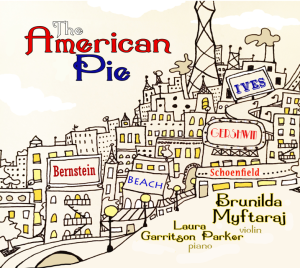“THE AMERICAN PIE”
Brunilda Myftaraj, violin
Laura Garritson Parker, piano
1. George Gershwin / Jascha Heifetz: “An American in Paris” (4:47)
Leonard Bernstein / arranged by Raimundo Penaforte: Suite from “West Side Story” for Violin and Piano
2. I feel Pretty (3:09)
3. Somewhere (3:53)
4. America (3:59)
5. Amy Beach: Romanza for Violin and Piano, op. 23 (6:36)
Charles Ives: Sonata for Violin and Piano, No. 4 “Children’s Day at the Camp Meeting”
6. Allegro (2:13)
7. Largo (6:17)
8. Allegro (1:35)
George Gershwin / Jascha Heifetz: “Porgy and Bess”
9. “Summertime” & “Woman Is a Sometime Thing” (3:28)
10. “My Man’s Gone Now” (3:58)
11. “It Ain’t Necessarily So” (2:31)
12. “Bess, You Is My Woman now” (3:19)
13. Tempo Di Blues (2:55)
Paul Schoenfield – “Four Souvenirs” for Violin and Piano
14. Samba (2:53)
15. Tango (3:41)
16. Tin Pan Alley (1:58)
17. Square Dance (3:12)
18. George Gershwin / Jascha Heifetz: Third prelude (1:17)
Recorded in Hartford, Connecticut in May, 2016
Adrian Sylveen – recording engineer
Katie Jurkiewicz: cover design
Virtuosi Records: All Rights Reserved
When you take a slice of the American music pie, you can’t be sure what the filling will be. Cut here, and it’s apple. Cut here, and it’s cherry. Just one slice won’t do it justice, so here we have a little sampling, as interpreted on the violin and piano.
The great violinist Jascha Heifetz (1901-1987) became an American citizen in 1925. For him to play music by George Gershwin (1898-1937), he made his own transcriptions, including the “Three Preludes for Piano,” and numbers from Porgy and Bess. Indeed, they show two different sides of Gershwin, as well as Heifetz. The preludes were meant to combine the new, American musical language with the classical tradition, while the latter are songs for the stage, and Heifetz faced different challenges in making them worthy encore pieces for a great violinist’s repertoire.
Leonard Bernstein (1918-1990) also bridged the gap between American popular styles and the classical tradition, and, like Gershwin, embraced the New York musical theatre. West Side Story, on which he collaborated with Stephen Sondheim (b. 1930), remains his most popular work, and the Brazilian-American composer Raimundo Penaforte (a Juilliard and NYU graduate) turned three of its songs into virtuoso music for violin and piano.
American concert music came into its own in the 20th century, and it had a running start thanks to musicians like Amy Beach (1867-1944) and Maud Powell (1867-1920). Both were recognized during their lifetimes as the foremost American women in their fields: Beach as a composer of concert music, and Powell as a virtuoso violinist. With Beach as pianist, the two performed the “Romance” at the World Columbian Exposition in Chicago in 1893. The achievements of both women are being recognized more and more today. For example, Powell was committed to bringing great music to small towns, and to small children, as she would schedule recitals en route between her concerts in the big city. Her pioneering recordings earned her the Grammy Lifetime Achievement Award in 2014.
One often thinks of Charles Ives (1874-1954) as the composer who in fact took American music into the 20th century, both chronologically and aesthetically. He wrote four violin sonatas: this is the last to be composed (or “assembled,” as is often the case with Ives), but it’s the first one he chose to publish. Ives wrote that “The subject matter is a kind of reflection, remembrance, expression, etc., of the children’s services at the outdoor summer camp meetings held around Danbury and in many of the farm towns in Connecticut…” Hints of hymns, sometimes subtle, sometimes not, flow through the music, with perhaps the centerpiece of the sonata being the reworking of “Jesus Loves Me” in the second movement. It was Ives’s original plan to make the violin part playable by his young nephew, but after the first movement, things didn’t turn out that way.
Paul Schoenfield was born in Detroit, Michigan, in 1947. His life has been dedicated to the study of the Talmud, music, and mathematics. Likewise, his music is an integration: Jewish and American, popular and folk, and the classical tradition. In the “Four Souvenirs,” the Latin style gives way to Tin Pan Alley, and we are back in Gershwin’s neighborhood. Then it’s a Square Dance, which is more like Ives’s Yankee fiddling. Yet none of these movements belongs solely to one style. The composer says that his music isn’t there to make you relax, but to make you sweat.
Dr. Michael Schiano
